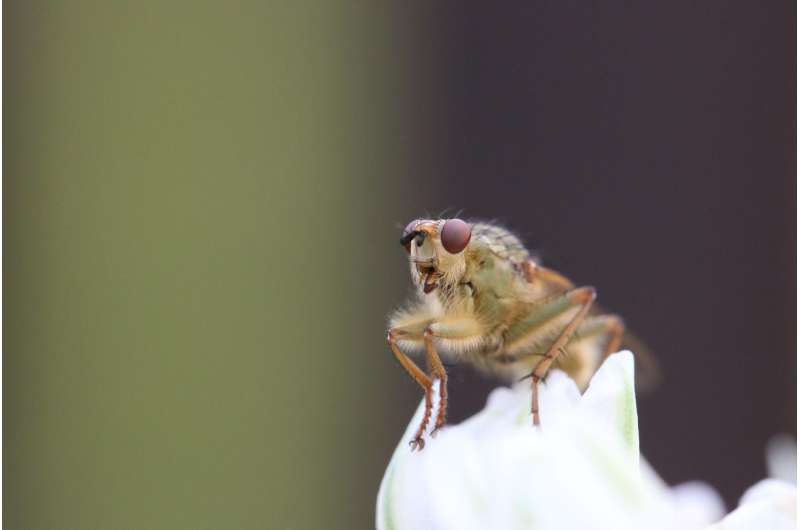May 5, 2017 report
Fruit fly brains found to have a ring of cells that work as a compass

(Phys.org)—A team of researchers with the Howard Hughes Medical Institute has found that a ring of cells in the middle of the fruit fly brain acts as a compass, helping the insect understand where it is, where it has been and where it is going. In their paper published in the journal Science, the team explains how they expanded on research they began two years ago and what their findings may mean for mammal internal navigation.
As the researchers note, two years ago, they discovered a group of approximately 50 neurons forming a ring in the center of the fruit fly brain that appeared to serve a navigational purpose. Since that time, they have studied how the ring might help the tiny insects make their way around in their environment.
To find out, the researchers affixed fruit flies to a metal rod that held them in place and then played virtual reality scenes around them, simulating movement in their natural environment. As a fly moved its wings attempting to fly in the simulated surroundings, the researchers recorded neural activity in the ring. They found that individual clusters in the ring would fire corresponding to the direction in which the fly was trying to move.
The researchers then genetically modified some of the neurons in the ring to activate when exposed to light. This allowed the team to manipulate the information the fly was receiving regarding its flight path. Firing light at the cells caused the fly to lose track of itself in its surroundings, strongly suggesting that the team was correct in their belief that the neural ring was similar to a compass. The team also ran similar experiments in which the flies were induced to fly in the dark, and found that though the fly appeared disoriented, it was not clear if it was due to interference by the team or just poor navigational skills in the dark in general.
As the researchers point out, their study offers evidence of the purpose of the neural ring, but does not explain how its nerves are activated, or how the fly receives information from the ring and uses it as a navigational aid. They plan to continue their research to see if they can find answers to such questions.
More information: Sung Soo Kim et al. Ring attractor dynamics in the Drosophila central brain, Science (2017). DOI: 10.1126/science.aal4835
Abstract
Ring attractors are a class of recurrent networks hypothesized to underlie the representation of heading direction. Such network structures, schematized as a ring of neurons whose connectivity depends on their heading preferences, can sustain a bump-like activity pattern whose location can be updated by continuous shifts along either turn direction. We recently reported that a population of fly neurons represents the animal's heading via bump-like activity dynamics. We combined two-photon calcium imaging in head-fixed flying flies with optogenetics to overwrite the existing population representation with an artificial one, which was then maintained by the circuit with naturalistic dynamics. A network with local excitation and global inhibition enforces this unique and persistent heading representation. Ring attractor networks have long been invoked in theoretical work; our study provides physiological evidence of their existence and functional architecture.
Journal information: Science
© 2017 Phys.org





















